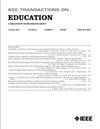Framework for Adoption of Generative Artificial Intelligence (GenAI) in Education
IF 2
2区 工程技术
Q2 EDUCATION, SCIENTIFIC DISCIPLINES
引用次数: 0
Abstract
Contributions: An adoption framework to include generative artificial intelligence (GenAI) in the university curriculum. It identifies and highlights the role of different stakeholders (university management, students, staff, etc.) during the adoption process. It also proposes an objective approach based upon an evaluation matrix to assess the success and outcome of the GenAI adoption. Background: Universities worldwide are debating and struggling with the adoption of GenAI in their curriculum. GenAI has impacted our perspective on traditional methods of academic integrity and the scholarship of teaching, learning, and research. Both the faculty and students are unsure about the approach in the absence of clear guidelines through the administration and regulators. This requires an established framework to define a process and articulate the roles and responsibilities of each stakeholder involved. Research Questions: Whether the academic ecosystem requires a methodology to adopt GenAI into its curriculum? A systematic approach for the academic staff to ensure the students’ learning outcomes are met with the adoption of GenAI. How to measure and communicate the adoption of GenAI in the university setup? Methodology: The methodology employed in this study focuses on examining the university education system and assessing the opportunities and challenges related to incorporating GenAI in teaching and learning. Additionally, it identifies a gap and the absence of a comprehensive framework that obstructs the effective integration of GenAI within the academic environment. Findings: The literature survey results indicate the limited or no adoption of GenAI by the university, which further reflects the dilemma in the minds of different stakeholders. For the successful adoption of GenAI, a standard framework is proposed 1) for effective redesign of the course curriculum; 2) for enabling staff and students; and 3) to define an evaluation matrix to measure the effectiveness and success of the adoption process.在教育领域采用生成式人工智能(GenAI)的框架
贡献:将生成式人工智能(GenAI)纳入大学课程的采用框架。它确定并强调了不同利益相关者(大学管理层、学生、教职员工等)在采用过程中的作用。它还提出了一种基于评估矩阵的客观方法,用于评估 GenAI 应用的成功和成果。背景:全世界的大学都在为在课程中采用 GenAI 而争论不休。GenAI 影响了我们对传统学术诚信方法以及教学、学习和研究学术的看法。由于缺乏行政部门和监管机构的明确指导,教师和学生对这种方法都不确定。这就需要有一个既定的框架来确定一个过程,并阐明每个利益相关者的角色和责任。研究问题:学术生态系统是否需要将 GenAI 纳入课程的方法?为学术人员提供一种系统方法,以确保采用 GenAI 后学生的学习成果得到满足。如何衡量和宣传大学采用 GenAI 的情况?研究方法:本研究采用的方法侧重于考察大学教育系统,并评估与将 GenAI 纳入教学相关的机遇和挑战。此外,本研究还确定了阻碍将 GenAI 有效融入学术环境的差距和综合框架的缺失。调查结果:文献调查结果表明,大学对 GenAI 的采用有限或根本没有采用,这进一步反映了不同利益相关者心中的困境。为了成功采用 GenAI,提出了一个标准框架:1)有效地重新设计课程设置;2)为教职员工和学生赋能;3)定义一个评估矩阵,以衡量采用过程的有效性和成功率。
本文章由计算机程序翻译,如有差异,请以英文原文为准。
求助全文
约1分钟内获得全文
求助全文
来源期刊

IEEE Transactions on Education
工程技术-工程:电子与电气
CiteScore
5.80
自引率
7.70%
发文量
90
审稿时长
1 months
期刊介绍:
The IEEE Transactions on Education (ToE) publishes significant and original scholarly contributions to education in electrical and electronics engineering, computer engineering, computer science, and other fields within the scope of interest of IEEE. Contributions must address discovery, integration, and/or application of knowledge in education in these fields. Articles must support contributions and assertions with compelling evidence and provide explicit, transparent descriptions of the processes through which the evidence is collected, analyzed, and interpreted. While characteristics of compelling evidence cannot be described to address every conceivable situation, generally assessment of the work being reported must go beyond student self-report and attitudinal data.
 求助内容:
求助内容: 应助结果提醒方式:
应助结果提醒方式:


